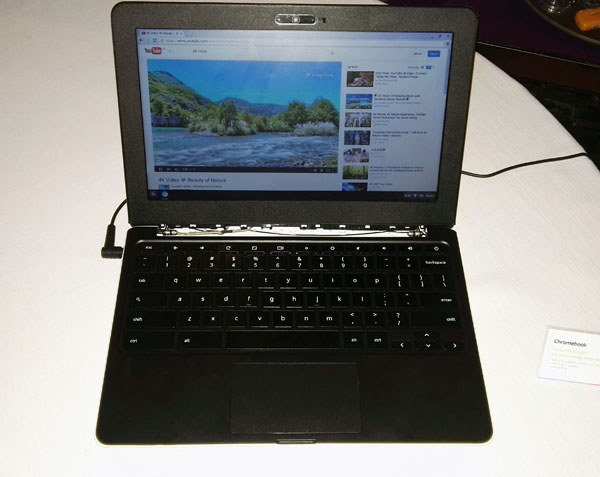Chromebooks were originally all based on Intel processor, but eventually ARM based Chromebooks got launched starting with Samsung Exynos, more recently Rockchip RK3288, and soon we’ll have Mediatek Chromebooks based on their latest Cortex A72 + A53 processor.
 The platform is still in development, but some prototypes are being shown up at Computex 2015 in Taipei. The full specs are not available but we do know the laptop features MT8173 SoC with 2x Cortex A72 cores, 2x Cortex A53 cores, and a PowerVR GX6250 GPU. NotebookItalia is at Computex and in their short video below with can hear the spokesman claiming support for 4K video playback, 2K display, and the presence of Type C USB port that can be used to connect device, but also charging the laptop.
The platform is still in development, but some prototypes are being shown up at Computex 2015 in Taipei. The full specs are not available but we do know the laptop features MT8173 SoC with 2x Cortex A72 cores, 2x Cortex A53 cores, and a PowerVR GX6250 GPU. NotebookItalia is at Computex and in their short video below with can hear the spokesman claiming support for 4K video playback, 2K display, and the presence of Type C USB port that can be used to connect device, but also charging the laptop.
Mediatek Chromebooks should offer about twice the single thread performance as Rockchip RK3288 devices, thanks to the use Cortex A72 cores instead of Cortex A17 and a higher clock frequency (up to 2.4 GHz vs up to 1.8 GHz).
No word on pricing and availability so far.
Via Liliputing

Jean-Luc started CNX Software in 2010 as a part-time endeavor, before quitting his job as a software engineering manager, and starting to write daily news, and reviews full time later in 2011.
Support CNX Software! Donate via cryptocurrencies, become a Patron on Patreon, or purchase goods on Amazon or Aliexpress




